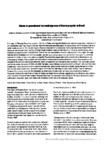Por favor, use este identificador para citar o enlazar este ítem:
http://www.alice.cnptia.embrapa.br/alice/handle/doc/16131Registro completo de metadatos
| Campo DC | Valor | Lengua/Idioma |
|---|---|---|
| dc.contributor.author | CERDEIRA, A. L. | pt_BR |
| dc.contributor.author | PARAIBA, L. C. | pt_BR |
| dc.contributor.author | KATAGUIRI, K. | pt_BR |
| dc.contributor.author | BOLONHEZI, D. | pt_BR |
| dc.contributor.author | GOMES, M. A. F. | pt_BR |
| dc.contributor.author | SOUZA, M. D. de | pt_BR |
| dc.contributor.author | PEREIRA, A. S. | pt_BR |
| dc.contributor.author | FARJANI NETO, C. | pt_BR |
| dc.contributor.author | MATALLO, M. B. | pt_BR |
| dc.date.accessioned | 2016-07-22T08:50:57Z | - |
| dc.date.available | 2016-07-22T08:50:57Z | - |
| dc.date.created | 2009-01-09 | pt_BR |
| dc.date.issued | 2008 | pt_BR |
| dc.identifier.citation | In: ANNUAL MISSISSIPPI WATER RESOURCES RESEARCH CONFERENCE, 38., 2008, Jackson. Proceedings... Jackson: Water Resources Research Institute, 2008. p.27-31. | pt_BR |
| dc.identifier.uri | http://www.alice.cnptia.embrapa.br/alice/handle/doc/16131 | pt_BR |
| dc.description | The region of Ribeirão Preto City located in São Paulo State, southeastern Brazil, is an important sugarcane, soybean and corn producing area. This region is also an important recharge area (Espraiado) for groundwater of the Guarany aquifer, a water supply source for the city and region. It has an intercontinental extension that comprises areas of eight Brazilian states, as well as significant portions of other South American countries like Argentina, Uruguay, and Paraguay, with a total area of approximately 1,200,000 Km2. Due to the high permeability of some soils present in this region, the high mobility of the herbicides and fertilizers applied, and being a recharge area, it is important to investigate the potential transport of applied fertilizers to underlying aquifer. The cultivation sugar cane in this area demands the frequent use of nitrogen as fertilizer. This research was conducted to characterize the potential contamination of groundwater with nitrogen in the recharge area of groundwater. Seven groundwater sample points were selected in the Espraiado stream watershed, during the years of 2005 and 2006. Samples were collected during the months of March, July, and December of each year. Three replications were collected at each site. Groundwater was also collected during the same months from county groundwater wells located throughout the city. The following six wells were studied: Central, Palmares, Portinari, Recreio Internacional, São Sebastião, and São José. Nitrate water samples were analyzed by Cadmium Reduction Method. No significant amount of nitrate was found in the recharge, agricultural, area. However, nitrate levels were detected at concentrations higher than the Maximum Concentration Level (MCL) of 10mg/L in downtown, urban, well located away from agricultural sites with no history of fertilizer or nitrogen application. | pt_BR |
| dc.language.iso | eng | eng |
| dc.rights | openAccess | eng |
| dc.subject | Água subterrânea | pt_BR |
| dc.title | Nitrate in groundwater in a recharge area of Guarany aquifer in Brazil. | pt_BR |
| dc.type | Artigo em anais e proceedings | pt_BR |
| dc.date.updated | 2016-07-22T08:50:57Z | pt_BR |
| dc.subject.thesagro | Poluição da Água | pt_BR |
| dc.subject.thesagro | Qualidade da Água | pt_BR |
| riaa.ainfo.id | 16131 | pt_BR |
| riaa.ainfo.lastupdate | 2016-07-21 | pt_BR |
| dc.contributor.institution | ANTONIO LUIZ CERDEIRA, CNPMA; LOURIVAL COSTA PARAIBA, CNPMA; Karen Kataguiri, Embrapa Meio Ambiente (Bolsista); Denizar Bolonhezi, UNICAMP; MARCO ANTONIO FERREIRA GOMES, CNPMA; MANOEL DORNELAS DE SOUZA, CNPMA; ANDERSON SOARES PEREIRA, CNPMA; Carlos Farjani Neto, DAERP; Marcus Bariffouse Matallo, Instituto Biológico de Campinas. | pt_BR |
| Aparece en las colecciones: | Artigo em anais de congresso (CNPMA)  | |
Ficheros en este ítem:
| Fichero | Descripción | Tamaño | Formato | |
|---|---|---|---|---|
| 2008AA099.pdf | 1.98 MB | Adobe PDF |  Visualizar/Abrir |









